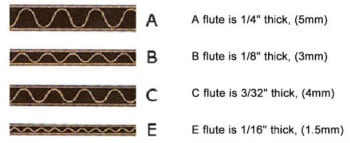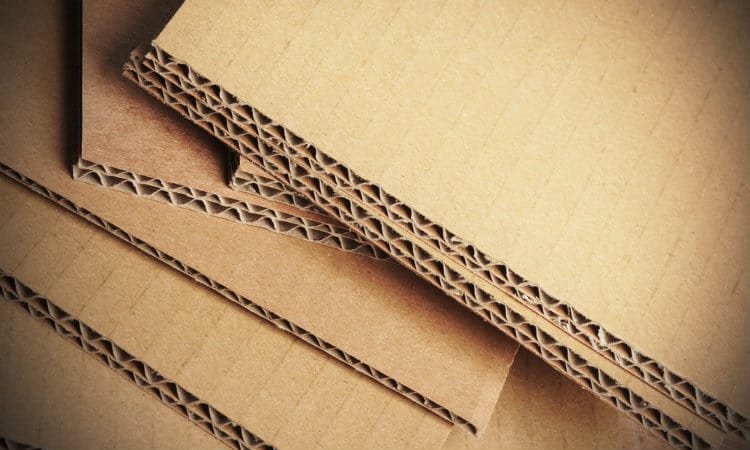Tired of having sounds travel from room to room through the walls? Is there anything you can do to reduce or block the sounds short of tearing down the walls and rebuilding them? If you don’t want to wear industrial soundproof ear protectors to bed, I have an inexpensive suggestion – cardboard.
Is cardboard good for soundproofing? Tests have shown that cardboard panels help reduce the movement of noise and may be just the answer you’re looking for. Corrugated cardboard doesn’t absorb sound; it reduces the transfer of noise and reduces the echo within a room. Many classroom teachers have been using it for more than 50 years too!
I’m not suggesting filling your room full of cardboard boxes. But by strategically placing some attractive homemade cardboard panels, you may have a better sleep.
Is Cardboard Good for Soundproofing?
We all experience noise differently and are irritated by different frequencies. Trying to find something to deaden or block the sound has become big business as people move closer together in cities. Cardboard is a recyclable material which may be a simple, inexpensive solution to your irritating noise problem.
Sound needs air to be able to travel. It doesn’t travel through a vacuum. The more air-tight a building or room’s construction, the more soundproof it will be. The only problem with this is that without air, creatures die and some machines don’t work.
The sound is a wave pattern that radiates out from whatever makes the noise and moves through the air. The distance between two wave crests is the pitch and the height of the wave the volume. Anything that can disrupt or absorb the wave will help reduce the sound.
 Corrugated cardboard is good for soundproofing. The two most common products available in corrugated formats are C-fluting and E-fluting. The C-fluting is more common and looks like a rolling wave between the two cardboard sheets, and E-fluting has a square chamber style.
Corrugated cardboard is good for soundproofing. The two most common products available in corrugated formats are C-fluting and E-fluting. The C-fluting is more common and looks like a rolling wave between the two cardboard sheets, and E-fluting has a square chamber style.
Studies done on the effectiveness of corrugated cardboard, which meets the ISO 354, identified that it is up to 40% more effective than standard gypsum drywall panels at dampening sound in the mid to high range. ISO is the International Organization for Standardization and 354 is the Measurement of Sound in their Acoustic section.
The tests were done using two layers of corrugated cardboard sandwiched together but aligned, so the “E” or “C” flutes were at 90-degrees to each other. The C-flute was about half as effective as the E-flute at deadening noise. Other tests used up to 6 layers to block the noise, including making a practice room for a band!
What that means to you and me is that the same people who test other soundproof materials have also found cardboard works! And 40% better than drywall is a whole lot better than most of us have!
Does Cardboard have Sound Absorption or Sound Dampening Properties?
The air spaces or pores in corrugated cardboard are key to its acoustic insulation ability. Although cardboard doesn’t absorb sound, it does significantly reduce the transfer of noise. The C-flute is not as effective as the E-flute at insulating sound, though. Panels with two layers will deaden up to 40% of the noise. Panels with more layers will further reduce the transfer of noise through the panels.
Does Cardboard Reflect Sound?
The smooth surface of the cardboard will reflect some sound waves, but some can pass right through it. Adding a smooth silvered surface (aluminum or tin foil) to one side however, will help it reflect more sound waves, and up to 95% of radio waves. Using foil could mess with your cell phone and other electronic reception though.
Can Corrugated Cardboard Help with Soundproofing?
Corrugated cardboard can help reduce the movement of sound into and out of a room. It can reduce the transfer of noise and reflect sound, and thus help deaden noise. If you have a study desk in a corner, several cardboard panels hung on the corner walls at desk height will reduce noise transfer and its distraction.
Cardboard Acoustic Panels
Cardboard acoustic panels can help reduce the transfer of noise by up to 40%. They can be hung on walls, attached to the ceiling, or suspended from the ceiling to provide noise absorption away from wall areas. Those suspended from ceilings can also act as baffles to help reduce the echo within a room.
E-fluted corrugated panels are more effective at dampening noise than the more common C-fluted panels. Two pieces of corrugated cardboard laminated so the flutes of each sheet are at 90 degrees improves the sound deadening abilities; more layers will improve the sound deadening properties too.
Cardboard panels are lightweight, inexpensive to make and can be made at home with readily available tools. All you need is corrugated cardboard panels, a utility knife, tape, glue, and some fishing line or wire for securing them to a surface.
They can be wrapped in colorful paper, painted, used to display posters or your children’s artwork.
Note: Although egg cartons are kind of like cardboard, please do not fall into the ‘Egg Carton as Soundproofing’ crowd. It does not work. See our article Egg Carton Soundproofing–It Doesn’t Work. Better Alternatives Here for more details.
Cardboard Box Soundproofing School Project
A popular middle and high school science project is to make a soundproof cardboard box. Students use a cardboard box and have to line it with materials to make it as soundproof as possible. A metronome or other noise device is placed inside the box. The box that prevents the most noise transferring through the box wins.
A household application for a soundproof or sound dampening box could be to house a sump pump, water pump, blender or electronic timer that produces a disturbing noise. The box would reduce the sound transfer and reduce the irritating noise.
To make the soundproof box for the science project:
- Get a corrugated box that is large enough for your plan.
- Seal all seams internally with caulking to prevent air movement, which is needed for sound to move.
- Line the box bottom and sides, and make an integrated “lid” arrangement that meshes and seals with the side layers. Use glue or a spray adhesive to stick the layers
- Use corrugated cardboard, egg box style foam, carpet, under-pad, towels, spray foam, styrofoam or even acoustic foam panels, etc. – or a combination of materials.
- Seal all seams where possible.
The box could be bottomless, so it sits over the noise making device, or have a removable section that is able to open so the metronome (or another noise device) can be installed.
Just for Fun: Vibe Danbocchi Wide Cardboard Soundproof Room
If you find the noise is disturbing your reading, studying, or you need something to practice a musical instrument in, check out the (Amazon). It weighs less than 70-pounds and is 43”x43”x64” when assembled. At around $2,000.00, it’s not a cheap solution, but you don’t have to make your own.
The room suppresses the transfer of noise in the wide middle range frequencies. The low and ultra-high ranges are slightly dampened, but will still transfer in or out. Other materials can be added to help suppress the high and low range frequencies. You can even .
Related Questions:
Can Cardboard Soundproof a Room? Corrugated cardboard has been used to make soundproof practice rooms for bands. Additionally, double thick panels of cardboard hung on the wall at head level behind a desk, chair or bed, are 40% more effective at reducing the transfer of sound into or out of a room than gypsum drywall.
Does Cardboard Reduce Noise? Cardboard is widely used as an inexpensive method to reduce noise. The fluting in corrugated cardboard reduces noise transfer and deadens noise into or out of a room. It also reflects some sound waves. Decorative panels are easy to make and can be hung on walls where noise reduction is needed.
Related posts:



dear Eugene, thank u so much.. i was frantically searching for some cheap household materials to complete a project (to make a good quality damping material for my newly constructed speaker box). i came across foam sheets, egg-crate paper, simple cotton layers, cardboard sheets (the brown thick compressed wood type) and even bubble wrap (plastic), but none were as simple as what you have suggested. It is easy to get, fix temporarily and remove without incurring any damage to any related parts. My only concern is whether it can be used inside the wooden speaker box and that if it will serve the purpose..!! Anyway, i will try and will share my expiriences if you or anybody else is interested.. Thanks once again
I live in the noisiest, paper- thin walled apartment complex ever. My apartment is in the middle, down stairs and encased between an apartment on the left and right of me, but also is enclosed at the top. My neighbor could release an SBD fart and although I couldn’t smell it the sound waves will travel into my apartment. I hear EVERY conversation in the outside hallway from my bedroom even with the door shut! So, rather than pay $30.00 to get the soundproof square foam sheets I decided to make my own from the cardboard boxes from my move. I’ll double up the squares, wrap in aluminum foil, then line the back of the squares with magnetic strips since my door is metal. I may even try using cotton or old t-shirts to in between the cardboard pieces just to give it a little more.
Hello,I have just read your response to is cardboard a good sound proofer? You described your idea of trying your own soundproofing squares, the way you described and the materials you suggested using? How did that work out for you? I’m mainly wondering how the aluminum foil sheeting interacted with the magnetic strips, did you have any cell phone signal issues after installing? Very intrigued.
Could you clarify what you mean by 90 degrees, with a diagram, in particlular for e-flute? Thanks.
Hi, thanks or the article.
Do you know if a combination of C and E cardboard at 90 degrees to each other would work better than just two E cardboard panels?
Should the panels be glued flush together, just placed together or separated with a small airspace?
Thanks
thanks,.. really appriciated this articale.. im going to load my bedroom with cardboard lol
Hi Khai,
Good to hear the article was helpful. Be careful what you wish for with all that cardboard in your bedroom.
Terry